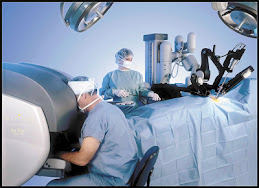http://www.smallcapreview.com/rbot.htm
Article in smallcappreview.com
Up until now, our research seems to indicate that the current world of robotic surgery is dominated by Intuitive Surgical Inc. and their robot known as the da Vinci robot. In order to better understand robotic surgery as a whole and not just the da Vinci system, we researched other robots that are either currently being used in surgery or have the potential to be used in the operating room in the near future.
The following article is a market review of Computer Motion Inc. (RBOT), which the article claims to be the “leader in medical robotics.” This article must have been slightly out of date because Intuitive Surgical Inc., after a 4-year legal power struggle, bought Computer Motion Inc. and currently markets the following products that the article promotes.
AESOP® was RBOT’s first robot. It is a voice-controlled endoscope-positioning robot. It imitates the form and function of a human arm has many benefits in an operating room. Operated by verbal commands, there is no need for other staff members to manually position the camera. At the same time, the video is very stable. The AESOP 3000 was the world’s first FDA-cleared robot that is capable in assisting in minimally invasive cardiothoracic surgeries.
The Hermes Control Center is the centralized system used to network an intelligent operating room. It allows the OR to be highly automated, more productive, better suiting the needs of patients and surgeons. The HERMES platform allows surgeons to operate tables, lights, cameras, and other surgical equipments by voice commands or hand-held touch screens from within the sterile operating field. This is a huge upgrade from using nurses or surgical assistants to constantly check the status of devices outside the sterile operating field. The entire OR staff can now focus on the patient as opposed to these devices.
The Zeus Robotic Surgical System is essentially RBOT’s version of the da Vinci system. It is designed to make incisions with tools that can be the diameter of a pencil tip. It provides a camera to allow surgeons to view the operation in 2D or 3D. Surgery is viewed by the surgeon via a monitor and controlled by instrument handles to eliminate hand tremor and reduces surgeon fatigue to ultimately make the entire surgery minimally invasive for the patients.
This article was very important in our understanding of robotic surgery. Firstly, it confirms our suspicion that the da Vinci Surgical System is not the only marketed and available robot in OR’s. This is slightly comforting because healthy competition in an industry always leads to better products. However, now that Intuitive Surgical Inc. has bought Computer Motion Inc., it will be interesting to see if a combined effort will catalyze the development of better robots.
Secondly, the article shows us that robotic surgery is more than simply finer tools and controls used to make precise incisions. Computer Motion’s products show us that robots are also used to develop highly intelligent operating room platforms for all surgeries, even manual ones, to go more smoothly.
Subscribe to:
Post Comments (Atom)

No comments:
Post a Comment